Interview with Stacie Johnson
Randee Silv
June 2019
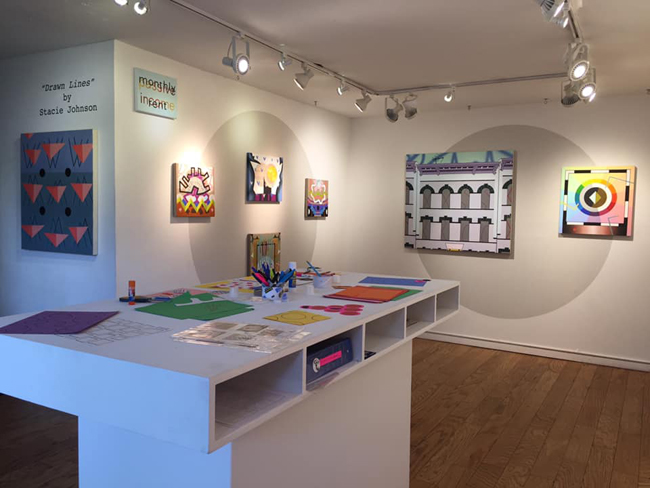 Stacie Johnson, Drawn Lines, Elijah Wheat Showroom
Stacie Johnson, Drawn Lines, Elijah Wheat Showroom
As soon as I entered the Elijah Wheat Showroom, I was immediately drawn to how each painting seemed to trigger conversations that go beyond the painted surface. I began imagining what they might be, knowing that everything around us from personal to political seeps into each gesture, each mark, each stroke. How do you see these concerns interacting with your visual language?
I agree that everything seeps into the work. In some ways, that’s why I often don’t intentionally try to craft a message with the work. I’m just as interested as anybody else to see what comes from my own experimentation.
How do I see my personal and political concerns interacting with my visual language? I’ll choose to answer this question in relation to my political concerns because I have been wrestling with this question and need to work it out. My visual language is so self-referential: re-iterating parts of other paintings and re-presenting my own process, that I have a hard time connecting the two concerns visually. I’m really only recently involved in politics and activism, but I find myself really good at is the tedious behind the scenes work. I like to do the research and the paperwork. I am often drawn to the smallest, at first seemingly inconsequential issue. It’s amazing how if you keep following one small issue, you will often find a big underlying problem. In that way, I definitely see my process as an activist similar to my creative process; I like to toss around stains and marks until I get a lead on how to proceed.
There are two paintings in this show that are representational. One is of my apartment building and the other is of my front gate. Obviously, these are literal references to my home, which is personal, but it is also my rent-stabilized apartment, which has instigated my awareness of a need for housing justice.
Yes, it sounds like there’s this parallel happening between how you make art & how you engage in activism, one influencing the other, one crossing into the other, that might show itself in unexpected ways. So, I’m curious, with your more abstract paintings, were there any compositional directions you found yourself taking that were perhaps influenced by what was on your mind politically at that moment?
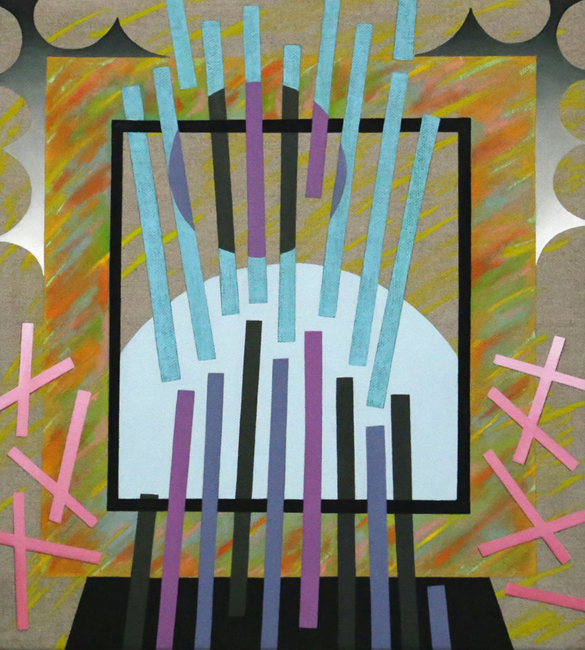 Rhythm Sticks
Rhythm Sticks
No, I don’t think so. The compositions of the abstract paintings seem completely independent from what is on my mind politically. I think they have more to do with art projects that I do with my kid, or expensive rugs that I look at online (but don’t buy).
Since spending more time on local political issues, if anything, the compositions have become more symmetrical and I use more obvious patterns. These are characteristics that I used to avoid because I thought they were too easy and too decorative. I don’t go to nearly as many art openings or studio visits as I used to, so I’ve let go of some of the “rules” I used to think were important for capital P painting. The paintings are now whatever I want to paint, for me, personally. I’m more likely to switch styles between one painting and the next. For example one painting in this show is a color wheel, only because I wanted a color wheel to reference in my studio.
The studio practice is a respite not only from politics but from the noise of life, but oddly one of my favorite things to listen to while I paint are city council hearings and community board meetings. This kind of audio is the perfect pace and length to compliment my sessions in the studio. It’s slow, but productive, and occasionally there are real fireworks.
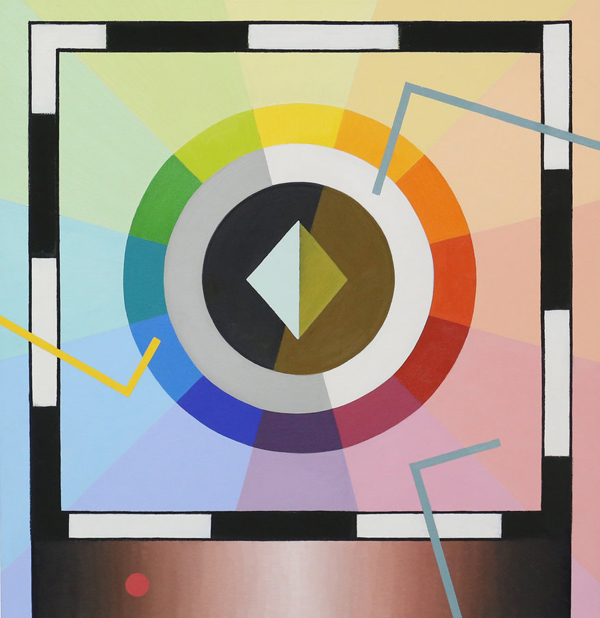 Color Wheel
Color Wheel
While I was painting, I’d listen to John Coltrane’s “A Love Supreme” non-stop. If it wasn’t on, my strokes seemed almost meaningless and empty. I was really into this invisible connection between what was inside his sound and where my gestures went. It’s really interesting as to what music artists gravitate towards while working. What are some of the issues brought up in these city council and community board meetings? Maybe you can bring us up to date on what’s going on.
Right now the community board meetings in Bushwick are about the city’s proposal to up-zone the neighborhood and how it doesn’t reflect the plan developed by the local residents and community based organizations. There are some extra fireworks around the loft law tenants versus the need to preserve manufacturing zones. The city council hearings that I listen to most often are education related. There is a lot of conversation right now about de-segregating the schools, how to reach equity in funding, and the related debate over the specialized high school entrance exam. It’s super interesting to peel back the layers of such an elaborate bureaucracy and it’s hours of uninterrupted audio to paint to, lol.
Joking aside, everyone should watch the February 2019 hearing on sexual harassment in the workplace in Albany. You can find the link atwww.harassmentfreealbany.com – the website of the Sexual Harassment Working Group.
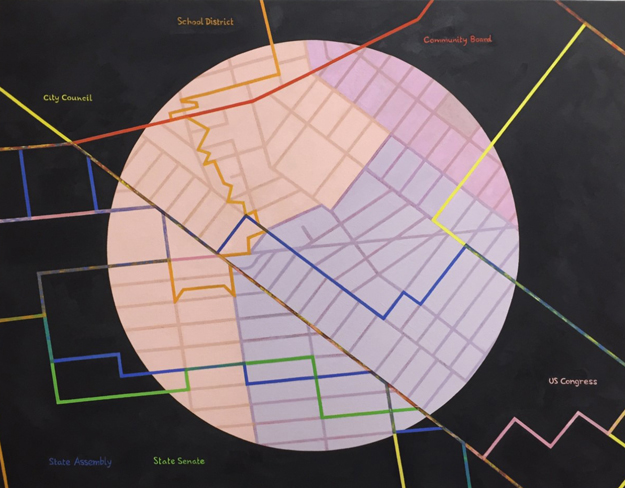 Drawn Lines
Drawn Lines
I see that the title for this exhibition comes from your painting Drawn Lines, which maps out the gerrymandered district boundaries within the half mile that surrounds the gallery. Could you talk more about how this project evolved, what you found, how it affects the neighborhood, as well as the piece Inequality and whatever messages might be embedded there for the viewer.
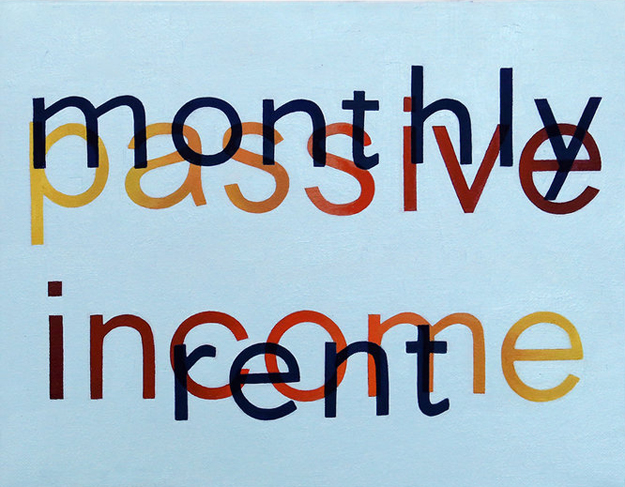 Inequality
Inequality
Both of these paintings were made specifically for Elijah Wheat Showroom. “Inequality” is a text painting that was made for EWS in November to take to the Anti-Art Fair in London. It simultaneously says “Monthly Rent” and “Passive Income.” The point was to express the absurdity that some people who have wealth can buy a building and live off of their tenant’s rent without having to get a job. Meanwhile, others are paying 50% of their income on rent and working two jobs.
Elijah Wheat Showroom has encouraged me to explore making more political work – because they knew what I was doing outside of the studio. “Drawn Lines” is a painting I made specifically for this exhibition in their Bushwick location. The center of the map is the exact location of EWS. Mapping the various district lines – school districts, community boards, city council districts, assembly districts – shows how relatively impossible it is to organize effectively. This specific location is not different than any other location across the city, as far as I can tell. This idea started from personal experience. I live right on the border of Bushwick, Brooklyn and Ridgewood, Queens, so my experience is really pronounced. That said, I’ve been shocked at just how complicated the various lines of governance are no matter where you live in NYC. It’s totally inefficient. I can’t imagine anybody really keeps track of who their local elected representatives are. You can get to know people at your community board meetings, but it’s likely you have different city council members. You can get to know other parents at your zoned public school, but it’s likely you have different state assembly members. You could get into a car accident two blocks from your home and have to deal with a police precinct that doesn’t cover your residence. I swear it’s a method to disenfranchise people power and for those in authority to constantly ‘pass the buck’ on responsibility. There are layers of layers of obfuscation in local government and this is one of them. This painting is just one example, and it could be a whole series, but I think I’d lose my mind making more than one of these.
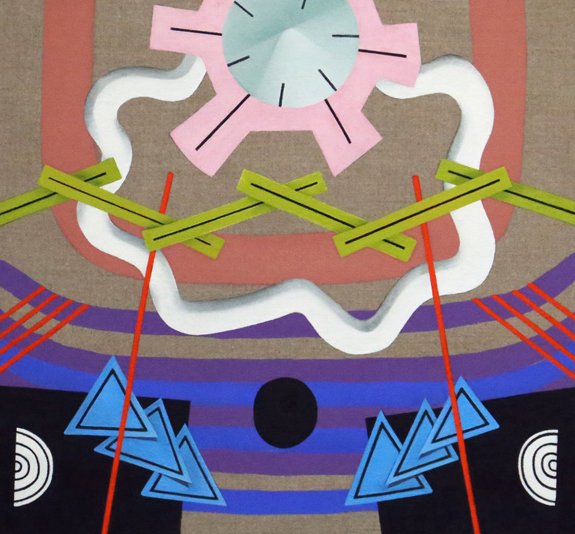 Sensitive Robot
Sensitive Robot
But in unravelling some of the complications communities face in organizing, you’re giving the viewer key information that can be turned into action. During the event last Sunday at EWS, “Stories from Tenants Who Fight Back,” you dealt with predatory equity, illegal tricks by landlords, unfair evictions, and the loopholes used to deregulate rent-stabilized apartments. This is especially timely & relevant since our rent laws are about to expire on June 15. Everyone needs to keep pressuring New York State legislators. These officials must support Universal Rent Control by passing all 9 bills. Housing is a human right. What’s planned for upcoming Sundays, and how can people get involved?
That event last week was pulled together at the last minute but based on a long time desire. I’ve always wanted to hear from individuals who fight back against landlords as an act of solidarity with their neighbors, rather than out of individual desperation. Most tenants who go to court with their landlord or who challenge illegal behavior do so because they have no other options. There are tons of tenants who don’t take it to that level. Many tenants relocate without struggle. Nobody wants to be an activist while in their own home, so it’s usually only the most desperate situations that inspire people to action. For this event, I was able to highlight individuals who are on the front lines of housing justice and who pursued their personal case for the benefit of preserving affordability for everyone. Unfortunately we did not get many people to come out for this event, but I hope to create a handout to preserve and share what we discussed.
Every Sunday, I hang out in the gallery to talk with passersby. What has been most effective is to use the map painting “Drawn Lines” to find out where people live and who represents them. I have a handout that lists the phone numbers of the elected officials and I can circle the elected officials relevant to their address. They can then leave with a personalized info sheet to hang on their fridge. If their state assembly member or state senator is not currently co-sponsoring the rent reform laws, I have another handout for that.
It has been the easiest to engage with people when I can lure them in with an activity that is not political and also not related to art. Last week, I gave out a ton of plant cuttings. I plan to do more activities on the sidewalk to catch the attention of people walking by. It might be as simple as letting kids blow bubbles and having some art-making materials on the table inside. I recently learned how to make pom-poms with plastic bags, so I’ll definitely bring the materials for that project on an upcoming Sunday.
Stacie Johnson
“Drawn Lines”
Elijah Wheat Showroom
Bushwick space @ 1196 Myrtle Ave
May 17 – June 23, 2019

